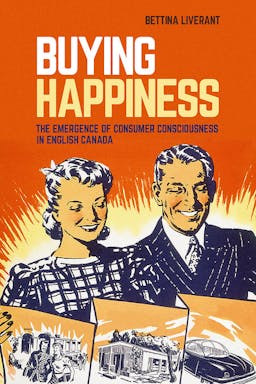
Book Review
Buying Happiness: The Emergence of Consumer Consciousness in English Canada, 2018
By Bettina Liverant
The nearest dictionary to hand unhelpfully defines consumer as “one or that which consumes”. Bettina Liverant takes us beyond linguistic tautologies to give us a first-rate intellectual history of consumer society in Canada from late Victorian times to the post-war baby boom era.
While the book is roughly chronological in organization, the chapters are mainly thematic betraying the origins of several of them as previously published stand-alone essays. But even those who have followed Liverant’s work closely will welcome the gathering together of this material into a sustained argument. At its heart that argument describes the dialectic between talking about consumer society and the object of that talk. As the chattering classes struggled to identify, define and debate the emergent consumer society they were also by so doing part of the shaping of that society. The usual suspects: Mackenzie King, Stephen Leacock, Harold (and Mary Quayle) Innis, Marshall McLuhan as well as lesser lights are rounded up for their thoughts about this new society taking shape. But such academic and middlebrow musing went on in a context of real changes in the commercial and business economy. Notably, from the 1890s on, we see the demoralization of business with national retailers, mail order catalogues and branding. Canadian consumers were urged to value country of origin labeling not place of manufacture – made in Canada was the boast, not that the factory was located in Sherbrooke or Brantford. Indeed the Canadian Manufacturers Association’s “Made-in-Canada” campaign just before and during World War One neatly combined nationalism with the notion of consumption itself as a Good Thing.
Were we all happy with this emerging new and, usually, more affluent society? Liverant cites some late Victorian social conservatives as positively opposed to material progress as it inexorably involved moral decline though I have a hard time buying that. Victorian ideals saw material and moral progress, especially via science and technology – about which Liverant says surprisingly little -- going hand-in-hand. Yes, grumpy conservatives adhering to the Marxist dictum of “whatever it is I’m against it” can always be found but we should not confuse their eccentric fulminations with mainstream opinion.
The state is a major player throughout the period examined by Liverant as she explicates the “relationship between Canadian consumers and the emergent managerial state” [95]. She deftly shows the importance of growing statistical knowledge in hands of the state and beyond; part and parcel of contemporary understanding of consumer society such knowledge thus helped to shape that society. Necessarily, this became political. In the challenging interwar period rising prices and cost of living became contentious issues. Populists and others still wedded to a producer ideology excoriated rapacious middle men and lamented the loss of face-to-face relationships in anonymous and abstract national markets. This culminated in H.H. Stevens quixotic attack on big business first in the Royal Commission on Price Spreads and then his short-lived Reconstruction Party. Liverant thus offers a welcome reinterpretation of the 1935 election in context of her story of emerging consumer society and shift in power to large, national firms.
Unquestionably the Canadian state during World War Two developed a variety of policies aimed at shaping the consumption practices of Canadians, including the blunt instrument of rationing. And yes there was wartime and even post-war shortages. But it is easy to exaggerate all that. Regulations could be and were worked around, ration levels were set very high and in practice consumption was remarkably little restrained with no real hardships on the home front, something that perhaps could have been emphasized more strongly.
One thing which could not possibly be exaggerated is the importance of gender and the feminization of household consumption. Liverant identifies the key role of Chatelaine in shaping the post-war, female, consumer and educating her in consumer skills as well as defining middle- class gender norms. The equation of consumer with a citizen was though a development seeming to transcend class. All are citizen consumers. Indeed class as a demographic category in consumer society meant income level and not relationship to the means of production. And, although the author doesn’t quite say this, mobility and not conflict was central to its meaning.
Like all good works of scholarship this book raises questions. What was the relationship of the emergence of consumer society to the modern, modernity and modernization, concepts Liverant uses but does not define? As the sub-title says, this book is about English Canada. We might guess how things played out differently in Quebec / French-Canada but it would be good to know. Just how different was consumer society in Ottawa or Hull, or in Verdun and East End Montreal? Liverant compares, (as did contemporary Canadians), Canadian consumer society with that of the United States. But what about the UK especially as in terms of living standards we outstripped our former colonial master? Was this consumer society the last step of the transformation of the family from a unit of production to a unit of consumption? Perhaps even was the rise of consumer society the Second Industrial Revolution’s equivalent of de Vries “Industrious Revolution”?
While informed by cultural theory, this study is no dense, dreary exercise in theoretical jargon mongering. Rather, Liverant has given us an engaging and eminently readable analytical narrative which should attract a diverse audience who will find in it matters of interest to their special concerns. Business historians will especially find intriguing her conceptualization of intellectual as well as social responses to changing business organization and practices. Buying Happiness is one of the least tendentious works of Canadian history it has been my pleasure to read in recent years, Liverant neither celebrates nor regrets the consumer society she describes but she does add considerably to our understanding of it.
James Hull
University of British Columbia